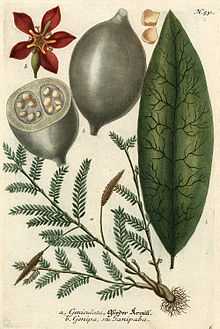Genipa americana
| Genipa americana | |
|---|---|
 | |
| Left:Geniculata. Right and top: Genipa americana. | |
| Scientific classification | |
| Kingdom: | Plantae |
| (unranked): | Angiosperms |
| (unranked): | Eudicots |
| (unranked): | Asterids |
| Order: | Gentianales |
| Family: | Rubiaceae |
| Genus: | Genipa |
| Species: | G. americana |
| Binomial name | |
| Genipa americana L. | |
| Synonyms | |
|
Genipa barbata Presl | |
Genipa americana is a species of Genipa, native to northern South America (south to Peru), the Caribbean and southern Mexico, growing in rainforests. It is commonly called Genipapo or Huito; the alternate name Jagua may refer to other species of Genipa as well. To the Inca, it was known as hawa or wituq. In the British islands of the West Indies, it was called the marmalade box.
It is a small tree growing to 15 m tall. The leaves are opposite, lanceolate to oblong, 20–35 cm long and 10–19 cm broad, glossy dark green, with an entire margin. The flowers are white, yellow or red, with a five-lobed corolla 5–6 cm diameter. The fruit is a thick-skinned edible berry 5–8 cm diameter.
A number of varieties and forms have been described:
- Genipa americana var. americana
- Genipa americana var. caruto K.Schum.
- Genipa americana var. riobranquensis Kuhlm.
- Genipa americana f. grandifolia Chodat & Hassl.
- Genipa americana f. jorgensenii Steyerm.
- Genipa americana f. parvifolia Chodat & Hassl.
The leaves are a food source for the caterpillars of the Fadus Sphinx Moth (Aellopos fadus).
Uses
Genipa americana is cultivated for its edible fruit, which are made into drinks, jelly, sherbert and used in ice cream. It is also said to be useful for treatment of candiru attacks. South American Indians bathe their legs in the clear liquid obtained from the fruit. The liquid has an astringent effect. When the liquid oxidizes, it stains the skin black. These stains are permanent, but only color the top few layers of skin, and thus disappear after about a fortnight, when the skin is naturally shed. As South Americans Indians went into battle, they used to paint themselves with Genipa juice and annatto.
The juice of the immature fruit is clear, but induces a chemical reaction on the human skin resulting in a tattoo-like dark blue. Used by rainforest natives as body-painting color. The ripened fruit of Huito is often eaten raw or made into jam. The fruit is brewed into a tea and taken as a remedy for bronchitis. Huito prefers alluvial soils, and grows very quickly (producing in 3 years), even in heavily flooded fields. This tree can be planted but more often than not it is dispersed by animals or water. It also serves as a very good climbing tree to reach other trees. In Puerto Rico, the fruit is placed in a glass container, refrigerated and used as a tonic. Folklore states that it contains "natural glass".
External links
- Germplasm Resources Information Network: Genipa americana
- USDA Plants Profile: Genipa americana
- HTMLized .pdf UNITED NATIONS CONFERENCE ON TRADE AND DEVELOPMENT - Market Brief in the European Union for selected natural ingredients derived from native species: Genipa americana, Jagua, huito (accessed 12 March 2006)
- .pdf version of above
- Datasheet from Rainforest Conservation